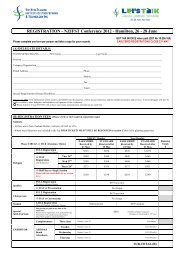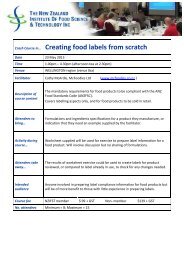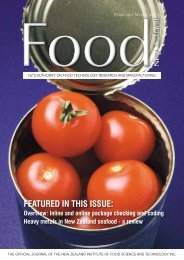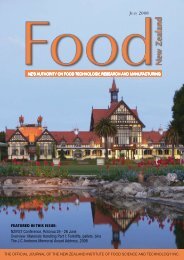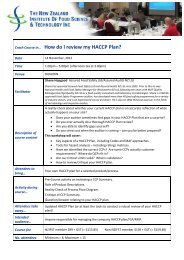featured in this issue - NZIFST - The New Zealand Institute of Food ...
featured in this issue - NZIFST - The New Zealand Institute of Food ...
featured in this issue - NZIFST - The New Zealand Institute of Food ...
You also want an ePaper? Increase the reach of your titles
YUMPU automatically turns print PDFs into web optimized ePapers that Google loves.
OILS & FATS<br />
Canadian <strong>in</strong>vention <strong>of</strong> all time. Fifty years ago, it did not exist. Back<br />
then, there was only a member <strong>of</strong> the brassica family (th<strong>in</strong>k mustard,<br />
cabbage, turnip, etc.) known as rapeseed, whose oil tasted bitter and<br />
conta<strong>in</strong>ed a type <strong>of</strong> fat (erucic acid) that is considered toxic. <strong>The</strong>n, <strong>in</strong><br />
the 1970s, Canadian agricultural scientists bred and cross-bred rape<br />
until it tasted sweet and the tox<strong>in</strong>s were all but gone. Note that was not<br />
genetic eng<strong>in</strong>eer<strong>in</strong>g but standard crop breed<strong>in</strong>g.<br />
<strong>The</strong> second is that <strong>this</strong> revolutionary vegetable oil – high <strong>in</strong> omega-3s,<br />
low <strong>in</strong> saturated fat – is possibly considered as heart-healthy as ref<strong>in</strong>ed<br />
olive oil. <strong>The</strong> leftover seed meal even boosts milk production <strong>in</strong> dairy<br />
cows. In 1978, the Western Canadian Oilseed Crushers’ Association<br />
christened <strong>this</strong> new and improved plant, jo<strong>in</strong><strong>in</strong>g “Canada” with the<br />
Lat<strong>in</strong> word for oil. (Some ma<strong>in</strong>ta<strong>in</strong> the name jo<strong>in</strong>ed “Canada” with<br />
“oil” and “low acid.” <strong>The</strong> controversy rages.)<br />
This year Canada will grow more than 13 million tonnes <strong>of</strong> the stuff –<br />
account<strong>in</strong>g for 20% <strong>of</strong> global production – and export almost $3-billion<br />
<strong>of</strong> oil. <strong>The</strong>y could go out and have a world class rugby team.<br />
<strong>Food</strong> labell<strong>in</strong>g (ad nauseam)<br />
<strong>The</strong> <strong>Food</strong> and Drug Adm<strong>in</strong>istration wants to revise the nutrition facts<br />
label(ho-hum) – that breakdown <strong>of</strong> fats, salts, sugars and nutrients on<br />
packag<strong>in</strong>g – to give consumers more useful <strong>in</strong>formation and help fight<br />
the national obesity epidemic.<br />
A proposal is <strong>in</strong> the works to change several parts <strong>of</strong> the label, <strong>in</strong>clud<strong>in</strong>g<br />
more accurate serv<strong>in</strong>g sizes, a greater emphasis on energy and a<br />
dim<strong>in</strong>ished role <strong>in</strong> the daily percent values for substances like fat, sodium<br />
and carbohydrates.<br />
It’s the latest attempt to improve the way Americans view food and<br />
make choices about what they eat, and comes <strong>in</strong> the wake <strong>of</strong> major<br />
advances <strong>in</strong> nutrition regulations by the Obama adm<strong>in</strong>istration.<br />
Calorie counts are popp<strong>in</strong>g up on menus <strong>of</strong> cha<strong>in</strong> restaurants across<br />
the country and the long stand<strong>in</strong>g food pyramid was toppled <strong>this</strong> year<br />
by the U.S. government <strong>in</strong> favour <strong>of</strong> a plate that gives a picture <strong>of</strong> what<br />
a healthy daily diet looks like.<br />
For two decades, the black and white label has <strong>of</strong>fered at-a-glance<br />
nutritional <strong>in</strong>formation about what’s <strong>in</strong>side each package, <strong>in</strong>clud<strong>in</strong>g<br />
calories and grams <strong>of</strong> fats, cholesterol, prote<strong>in</strong> and carbohydrates. Critics<br />
have compla<strong>in</strong>ed it’s confus<strong>in</strong>g and doesn’t <strong>of</strong>fer a simpler way to<br />
make a choice about whether it’s good for them – a judgment the<br />
<strong>in</strong>dustry wants to leave to consumers. <strong>The</strong>re is an easier way – stop<br />
eat<strong>in</strong>g so much.<br />
Krill oil<br />
Whilst the topic <strong>of</strong> sav<strong>in</strong>g the orang-utans cont<strong>in</strong>ues to plague the<br />
palm oil <strong>in</strong>dustry, consider also the fate <strong>of</strong> the Antarctic pengu<strong>in</strong>. <strong>The</strong>re<br />
has been a suggestion that wholesale harvest<strong>in</strong>g <strong>of</strong> krill may endanger<br />
the pengu<strong>in</strong> population. This may be another hot topic to occupy those<br />
who are bored with the Rugby World Cup.<br />
Proceed<strong>in</strong>gs <strong>of</strong> the National Academy <strong>of</strong> sciences (doi: 10.1073/<br />
pnas.1016560108)<br />
RWC lipid trivia<br />
Everyth<strong>in</strong>g revolves around lipids. <strong>The</strong> reason that our esteemed<br />
friends <strong>in</strong> the Wallabies (Australian rugby team) went down to the Irish<br />
was possibly because they are full <strong>of</strong> trans fats. This is a serious scientific<br />
reference to the work <strong>of</strong> Hartman and Shorland who quoted the<br />
follow<strong>in</strong>g: “<strong>The</strong> highest percentages <strong>of</strong> trans-acids were found <strong>in</strong> the<br />
fats <strong>of</strong> the quokka (21-30%) and the wallaby (18.1-19.2 %).<br />
Annual Reviews: (1956) Shorland, F.B., et. al. Pp 101-122<br />
Carol Barnao,<br />
Chair <strong>of</strong> MAF’s<br />
<strong>Food</strong> &<br />
Biosecurity<br />
Management<br />
Group.<br />
Knowledge is a powerful food<br />
safety tool<br />
<strong>The</strong> world looked on <strong>in</strong> shock as the German food poison<strong>in</strong>g crisis<br />
unfolded earlier <strong>this</strong> year, leav<strong>in</strong>g more than 50 people dead and<br />
hundreds <strong>of</strong> people with serious and potentially lifelong health<br />
complications. After <strong>in</strong>tensive <strong>in</strong>vestigations the German authorities<br />
determ<strong>in</strong>ed that a particularly virulent stra<strong>in</strong> <strong>of</strong> E. coli, STEC O104,<br />
<strong>in</strong> bean sprouts was the cause <strong>of</strong> the outbreak there.<br />
Because food can – and occasionally does – cause grave harm to<br />
people who eat it, we as the food safety regulators, have to cont<strong>in</strong>ually<br />
seek out the most up-to-date science and <strong>in</strong>formation to ensure<br />
we are well equipped to deal with a potential foodborne illness outbreak<br />
here <strong>in</strong> <strong>New</strong> <strong>Zealand</strong>.<br />
At MAF we are privileged to have an <strong>in</strong>volved science fraternity that<br />
we can draw on to ensure the best advice and help is available<br />
when specific <strong>issue</strong>s arise, or <strong>in</strong> emergency situations. Our <strong>Food</strong><br />
Safety Science Academy <strong>in</strong> particular, provides us with access to a<br />
wealth <strong>of</strong> external technical expertise and knowledge, and these<br />
are people who are familiar with our core bus<strong>in</strong>ess.<br />
To ensure we <strong>in</strong> <strong>New</strong> <strong>Zealand</strong> are well equipped to detect and deal<br />
with a major <strong>in</strong>cident <strong>in</strong>volv<strong>in</strong>g an exist<strong>in</strong>g E. coli STEC or the emergence<br />
and spread <strong>of</strong> a new variant, MAF – with the help <strong>of</strong> Massey<br />
University – recently brought together Academy members and researchers<br />
from around the country with an active <strong>in</strong>terest <strong>in</strong> STEC’s.<br />
It proved to be a very useful round-table discussion. We were able<br />
to consider areas where <strong>New</strong> <strong>Zealand</strong>-specific research is needed<br />
or new laboratory methods have to be developed for specific types<br />
<strong>of</strong> STEC’s.<br />
General consensus was that <strong>New</strong> <strong>Zealand</strong> is already tak<strong>in</strong>g a proactive<br />
approach to ga<strong>in</strong><strong>in</strong>g a deeper understand<strong>in</strong>g <strong>of</strong> STEC’s.<br />
Epidemiological <strong>in</strong>vestigations to date do not <strong>in</strong>dicate that food is a<br />
primary source. Other possibilities <strong>in</strong>clude occupational exposure<br />
and water. <strong>The</strong> risk factors for human illness <strong>in</strong> <strong>New</strong> <strong>Zealand</strong> are<br />
currently be<strong>in</strong>g sought <strong>in</strong> a year long human case control study and<br />
the results will be used to review controls currently <strong>in</strong> place.<br />
MAF has worked closely with the Meat Industry Association over<br />
many years, evaluat<strong>in</strong>g the presence <strong>of</strong> and means to control STEC’s<br />
when they do occur on red meat, and is currently co-fund<strong>in</strong>g a PhD<br />
study to further that work. This research is exam<strong>in</strong><strong>in</strong>g the presence<br />
<strong>of</strong> STEC’s on-farm and what happens when animals leave the farm<br />
and are transported and processed at the slaughterhouse.<br />
I would like to take the opportunity to thank the members <strong>of</strong> the<br />
Academy – as well as the other scientists who make themselves<br />
available on a case-by-case basis. <strong>The</strong>ir help enables us to respond<br />
to <strong>issue</strong>s us<strong>in</strong>g the best science available at the time.<br />
Presentation papers from the STEC roundtable will be made available<br />
on MAF’s food safety website shortly at www.foodsafety.govt.<br />
nz/about/academy/.<br />
www.foodsafety.govt.nz<br />
October/November 2011 31



